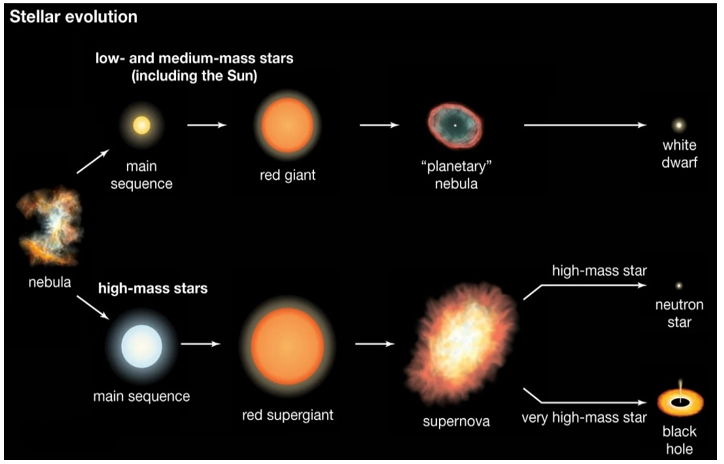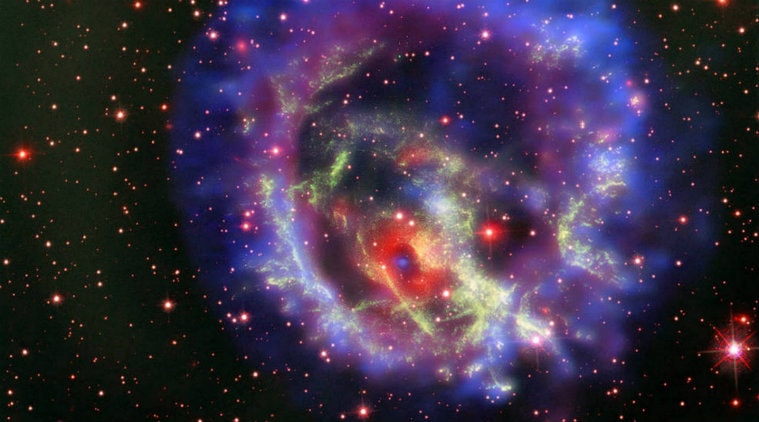SYLLABUS
GS-3: Achievements of Indians in science & technology; Awareness in the field of Space.
Context:
A recent study has identified a chemical link between lithium-rich red giant stars and their enhanced helium abundance, offering fresh insights into stellar evolution during the red giant phase.
More on the News
The study was conducted by the Indian Institute of Astrophysics, an autonomous institute of the Department of Science and Technology (DST), using data from the Himalayan Chandra Telescope and global archival sources.
- The Himalayan Chandra Telescope (HCT) is a 2-meter optical-infrared telescope located at the Indian Astronomical Observatory in Hanle, Ladakh.
The discovery offers a new lead in understanding the chemical and structural changes occurring during the red giant evolutionary stage.
Indian Institute of Astrophysics (IIA)
- IIA traces its origin to the Madras Observatory, started in 1786, and moved to Kodaikanal, Tamil Nadu, in 1899.
- Later renamed as the Kodaikanal Observatory, it has been functioning as a full-fledged solar and stellar observatory.
- In its present form, the Indian Institute of Astrophysics was set up in 1971 as an autonomous research institution to conduct research in Astronomy, Astrophysics, and allied areas of Physics.
- The institute is funded by the Department of Science and Technology, Government of India.
- IIA’s headquarters was shifted to Bengaluru to its present campus in Koramangala in 1975.
Key Highlights of the Study
The study infers helium abundance by first measuring deviations in hydrogen abundance in the stellar atmosphere (the outer layer of a star where light originates).
The study infers helium abundance by first measuring deviations in hydrogen abundance in the stellar atmosphere (the outer layer of a star where light originates).
- Helium cannot be directly observed in cool stars because their surface temperature is not high enough to excite helium spectral lines.
The team compared magnesium abundances derived from atomic and molecular spectral lines (light patterns used to identify elements in a star) to determine hydrogen levels accurately.
The change in hydrogen is used to derive helium abundance through model atmospheres constructed for different hydrogen-to-helium ratios.
The researchers applied this method to a sample of eighteen red giants and two supergiants using high-resolution spectral data.
The analysis showed that six stars had helium levels higher than the standard He/H ratio of 0.1.
Five of these helium-enhanced stars were red giants, and one was a supergiant.
- The main difference is that red giants are from low to intermediate-mass stars, while red supergiants are from much more massive stars.
- Red supergiants are significantly larger, more luminous, and have a shorter lifespan that ends in a supernova, whereas red giants are smaller and eventually become a white dwarf.
The study reports that all helium-enhanced red giants were also super lithium-rich, while the lone supergiant was an exception.
However, the reverse was not always true, i.e., not all lithium-rich giants showed helium enhancement, suggesting a one-way but not universal chemical link.
The findings confirm that helium enrichment in the photosphere of red giants is accompanied by lithium enrichment.
This is the first spectroscopic determination of photospheric helium abundance in both normal and lithium-rich field giants.
About Stellar Evolution and its Stages
Stellar evolution is the process of changes a star undergoes throughout its life, from its birth in a cloud of gas and dust to its eventual death, which depends primarily on its mass.
Stellar Evolution Stages Nebula: A large cloud of gas and dust where star formation begins through gravitational collapse.

- Nebula: A large cloud of gas and dust where star formation begins through gravitational collapse.
- Protostar: A contracting mass of gas that heats up but has not yet begun nuclear fusion.
- Main-Sequence Star: Stable phase where hydrogen fuses into helium, producing energy and balancing gravity.
- Red Giant / Red Supergiant: After core hydrogen exhaustion, low/medium-mass stars expand into red giants, while high-mass stars evolve into red supergiants.
- Planetary Nebula (for Sun-like stars): Outer layers are shed, leaving behind the hot core.
- White Dwarf (final state of low/medium-mass stars): Dense, Earth-sized remnant that cools slowly over time.
- Supernova (for massive stars): A massive star explodes after core collapse, dispersing heavy elements.
- Neutron Star (post-supernova outcome): Extremely dense remnant composed mostly of neutrons.
- Black Hole (for most massive stars): A collapsed core with gravity so strong that not even light can escape.

